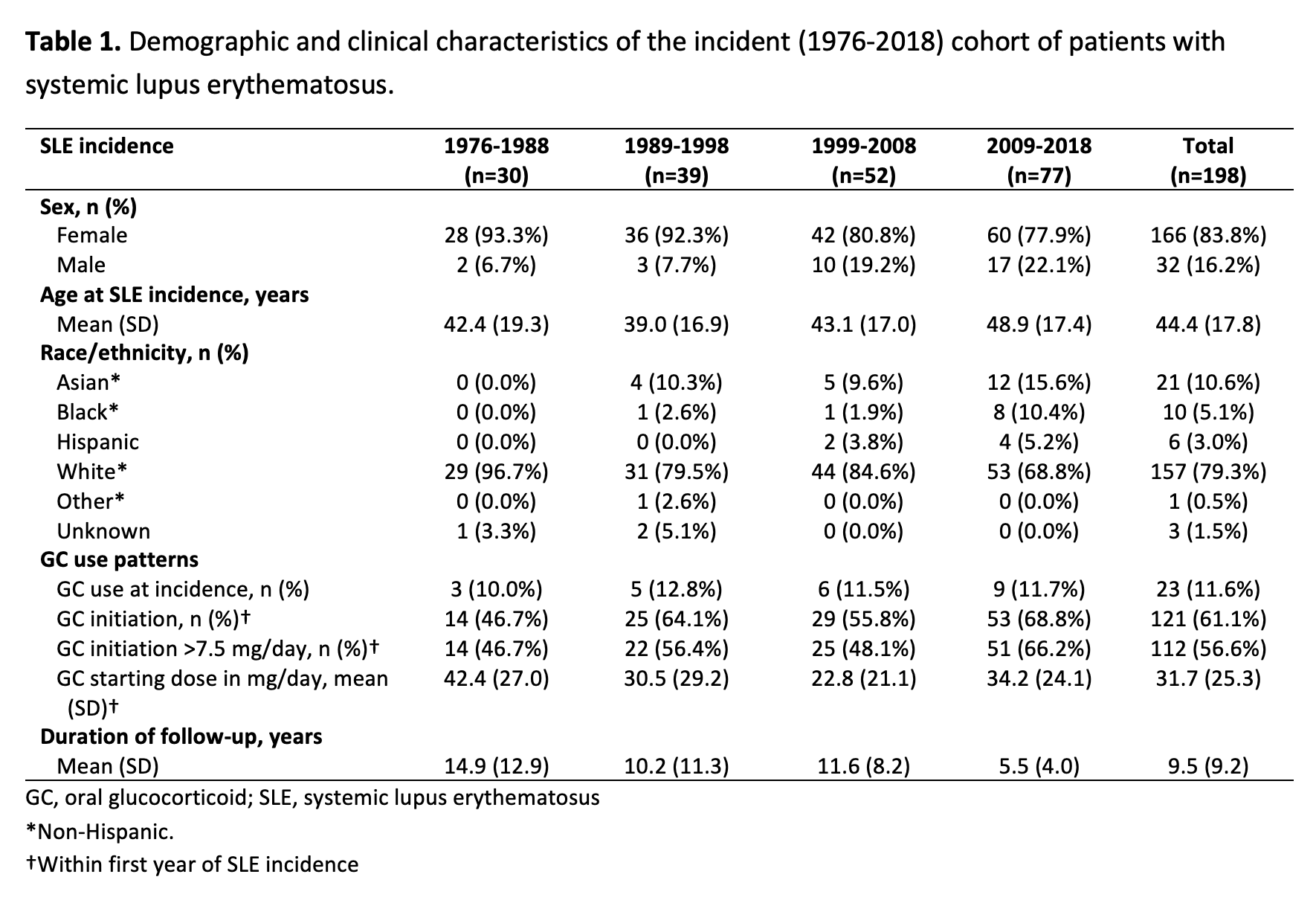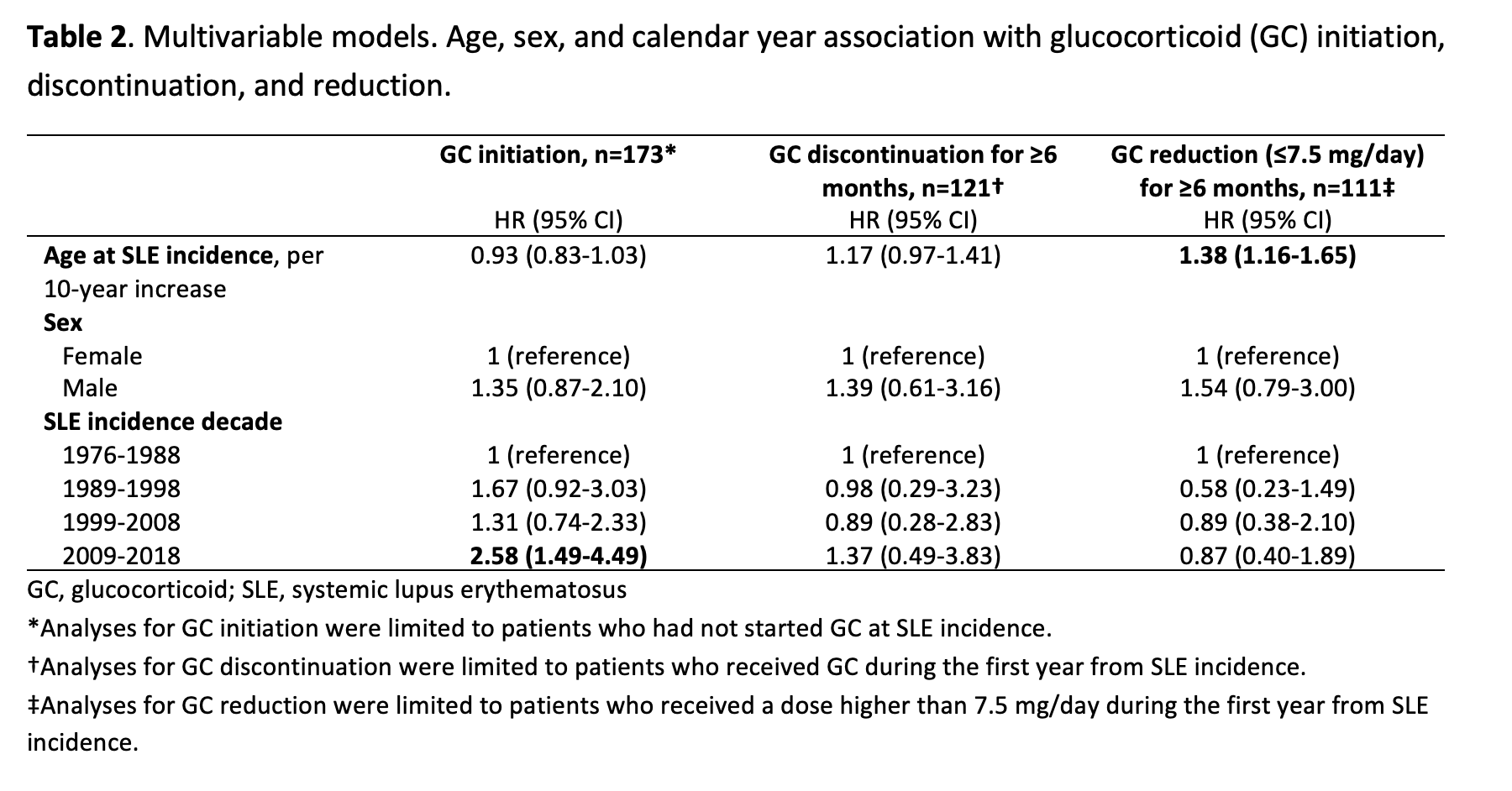Session Information
Date: Monday, November 18, 2024
Title: SLE – Treatment Poster III
Session Type: Poster Session C
Session Time: 10:30AM-12:30PM
Background/Purpose: We examined the patterns of glucocorticoid (GC) use and the temporal trends of GC initiation, discontinuation, and reduction over four decades in a population-based incident cohort of patients with SLE.
Methods: Patients meeting the 2019 EULAR/ACR SLE classification criteria between 1976-2018 from a county were included. Index date was defined as the date of criteria fulfillment. GC use (oral daily prednisone equivalents) was abstracted from the index date until death or last follow-up through December 2023. GC initiation was defined as the time GCs were first started at any dose or duration after index. GC discontinuation was assessed for patients who were on GC at any dose through the first year following index date. GC reduction was assessed for those with dosages >7.5 mg/day during the first year from the index. GC discontinuation was defined as the time GCs were first stopped for ≥6 months, whereas GC reduction was established when a dosage ≤7.5 mg/day was reached for the first time and maintained for ≥6 months. We estimated the cumulative incidence of GC initiation, discontinuation, and reduction using Kaplan-Meier methods. Cox proportional hazard models adjusted for age and sex were used to calculate hazard ratios (HR) with 95% confidence intervals (CI) of GC initiation, discontinuation, and reduction per decade.
Results: We included 198 patients with SLE. The mean age was 44.4 ± 17.8 years; 166 (84%) were female, and 23 (12%) were already receiving GCs at SLE incidence. The demographic and GC use characteristics per decade are displayed in Table 1. After excluding patients who were receiving GCs at index, 141/175 (80.6%) patients were started on GCs during the follow-up period. The six-month and two-year GC initiation rates were 52.3% (95% CI 44.3-59.2) and 61.2% (95% CI 53.2-67.8), respectively (Figure 1A). Regarding GC discontinuation, 35/121 (28.9%) patients taking GCs during the first year from index were able to discontinue at some point in the follow-up period. GC discontinuation occurred predominantly within two years of the index (38.5%, 95% CI 26.7-48.3; Figure 1B). Of 112 patients who were on a GC dosage >7.5 mg/day within the first year from index, 53 (47.3%) reached GC reduction during the follow-up. At two years, the GC reduction rate was 66.0% (95% CI 52.9-75.5; Figure 1C). Patients with SLE incidence during the 2009-2018 decade had a higher likelihood of GC initiation compared to patients from the 1976-1988 decade after adjusting for age and sex (HR 2.58, 95% CI 1.49-4.49; Table 2). There was no difference by decade of SLE incidence for the GC discontinuation and reduction outcomes. Patient age at SLE incidence was associated with a 38% increased likelihood of GC reduction per every 10-year increase in age (HR 1.38, 95% CI 1.16-1.65).
Conclusion: In this study, GC initiation in SLE occurred mostly within the first six months of the disease. The rates of GC discontinuation and reduction were low, and when these outcomes were achieved, they typically occurred within two years of SLE incidence. More patients with SLE are currently initiating GCs at higher doses than in previous decades; however, the rates of GC discontinuation and reduction have not changed over time.
To cite this abstract in AMA style:
Gonzalez-Trevino M, Flores Gouyonnet J, Xu Q, Hulshizer C, Meade-Aguilar J, Navarro-Mendoza E, Bautista-Vargas M, Figueroa-Parra G, Sanchez-Rodriguez A, Cuellar-Gutierrez M, Hanson A, Crowson C, Duarte-Garcia A. Trends in Glucocorticoid Use in Systemic Lupus Erythematosus in a Population-Based Inception Cohort from 1976 to 2018: The Lupus Midwest Network [abstract]. Arthritis Rheumatol. 2024; 76 (suppl 9). https://acrabstracts.org/abstract/trends-in-glucocorticoid-use-in-systemic-lupus-erythematosus-in-a-population-based-inception-cohort-from-1976-to-2018-the-lupus-midwest-network/. Accessed .« Back to ACR Convergence 2024
ACR Meeting Abstracts - https://acrabstracts.org/abstract/trends-in-glucocorticoid-use-in-systemic-lupus-erythematosus-in-a-population-based-inception-cohort-from-1976-to-2018-the-lupus-midwest-network/



